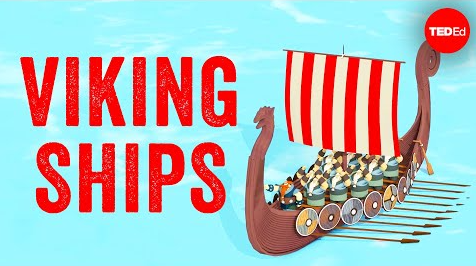The Vikings came from the rugged, inhospitable north known today as Scandinavia.
维京人来自崎岖、荒凉的北方,也就是今天的斯堪的纳维亚。
As the Roman Empire flourished further south, Scandinavians had small settlements, no central government, and no coinage.
随着罗马帝国进一步向南扩张,斯堪的纳维亚人居住范围小,没有中央政府,也没有货币。
Yet by the 11th century, the Vikings had spread far from Scandinavia,
然而到了十一世纪,维京人已从斯堪的纳维亚半岛蔓延到达了很远的地方,
gaining control of trade routes throughout Europe, conquering kingdoms as far as Africa, and even building outposts in North America.
控制了整个欧洲的贸易路线,征服了远至非洲的王国,甚至在北美建立了前哨站。
The secret to their success was their ships. The formidable Viking longship had its origins in the humble dugout canoe, or log boat.
其成功秘诀就是他们的船只。强大的维京长船起源于简陋的独木舟。
For millennia, the inhabitants of Scandinavia had used these canoes for transportation.
数千年来,斯堪的纳维亚的居民一直使用这些独木舟来运输。
Dense forests and tall mountains made overland travel difficult, but long coastlines and numerous rivers, lakes, and fjords provided a viable alternative.
茂密的森林和高山令陆路旅行困难重重,但漫长的海岸线和众多的河流、湖泊和峡湾提供了可行的选择。
The first canoes were simply hollowed out logs rowed with paddles.
最早的独木舟只是掏空的树干,用船桨划动前行。
Over time, they added planks to the log boat base using the clinker, or "lapstrake," technique, meaning the planks overlapped and were fastened to each other along their edges.
随着时间的推移,他们使用船壳板堆压(也称为叠压)技术,在船基座上增加了木板,即将交叠的船板沿边缘固定在一起。
As the Roman Empire expanded north, some Scandinavians served in their new neighbors' armies -- and brought home Roman maritime technology.
随着罗马帝国向北扩张,一些斯堪的纳维亚人在新邻国的军队里服役,并带回了罗马的航海技术。
The Mediterranean cultures at the heart of the Roman Empire had large warships that controlled the sea, and cargo ships that transported goods along the waterways.
罗马帝国核心的地中海文化有大型战舰控制着海洋,还有货船沿水路运输货物。
These ships were powered by sail and oars and relied on a strong skeleton of internal timbers fastened to the outer planks with copper, iron, and wood nails.
这些船由帆和桨提供动力,依靠坚固的内部木材骨架,用铜、铁和木钉固定在外板上。
At first, Scandinavians incorporated this new technology by replacing their loose paddles with anchored oars.
起初,斯堪的纳维亚人采用了这种新技术,用固定桨取代了自由单桨。
This change hugely improved the crew's efficiency, but also required stronger ships.
这一改变极大提高了船员的效率,但也需要更强大的船。
So boat builders began to use iron nails for fasteners rather than sewing.
因此造船工人不再使用拼接工艺,开始用铁钉加固船板。
They abandoned the log boat base for a keel plank, and the boats became higher and more seaworthy.
船底不再是独木舟基底,而是改用龙骨板,船变得更高,且更适合航海。
But these early ships retained the concept of the original log boat: their strength depended on the outer shell of wood, not internal frames and beams.
但这些早期船只保留了原始独木舟的概念:船的强度取决于外壳木材,而不是内部框架和梁。

They were built as shells -- thin-walled but strong, and much lighter than the Roman ships.
船建得像贝壳一样--薄壁但坚固,比罗马船轻得多。
Competing chieftains quickly refined the new ships to be even more efficient.
相互竞争的首领们迅速改进新船,使其更高效。
The lighter the boat, the more versatile it would be and the less investment of resources it would require
船越轻,它的用途就越广,所需投入的资源就越少,
an essential advantage in a decentralized culture without large supplies of people.
对一个没有大量人力并去中心化的文化来说,这是一项基本优势。
These ships still had no sails -- sails were costly, and for now the rowed ships could meet their needs.
这些船仍然没有帆--船帆很昂贵,当时划桨船可以满足他们需求。
That changed after the Western Roman Empire collapsed in the 5th century.
在西罗马帝国五世纪灭亡后,情况发生了改变。
Western Europe took a heavy economic blow, leveling the playing field a bit for the Scandinavians.
西欧遭受了沉重的经济打击,为斯堪的纳维亚人提供了一个公平的竞争环境。
As the region revived, new and vigorous trade routes extended into and through Scandinavia.
随着该地区的复苏,充满活力的新贸易路线延伸并通过斯堪的纳维亚。
The wealth that flowed along these routes helped create a new, more prosperous and powerful class of Scandinavians,
沿着这些路线流动的财富催生了一个更繁荣、更强大的新斯堪的纳维亚阶级,
whose members competed constantly with each other over trade routes and territory.
其成员之间不断争夺贸易路线和领土。
By the 8th century, a sailing ship began to make sense: it could go further, faster, in search of newly available plunder.
到了八世纪,帆船才应运而生:在搜寻新战利品时,它可以航行更快、更远。
With the addition of sails, the already light and speedy ships became nearly unbeatable.
船加上船帆后,本来就轻而快的船只变得几乎不可战胜。
The Viking ship was born. Viking longships could soon carry as many as 100 Vikings to battle.
维京船诞生了。维京长船可以快速运载多达100名维京人去战斗。
Fleets of them could land on open beaches, penetrate deep into river systems, and be moved over land if need be.
船队可以在开阔海滩上登陆、也可以深入到河流系统,如果需要的话,还可以运到陆地上。
When not at war, the vessels were used to transport goods and make trade journeys.
在非战争时期,这些船被用来运输货物和进行贸易旅行。
There were smaller versions for fishing and local excursions, and larger adaptations for open sea voyages capable of carrying tens of tons of cargo.
有用于钓鱼和本地短途旅行的型号小一点的船只,也有用于海上航行的大型号船,可以装载数十吨货物。
Thanks to their inventiveness in the face of difficult terrain and weak economies, the Vikings sailed west,
面对恶劣地理条件和经济疲软的形式,维京人得益于其创造性,他们才能向西航行,
settled the North Atlantic and explored the North American coast centuries before any other Europeans would set foot there.
在北大西洋定居,并探索北美海岸,比其它欧洲人涉足此地要领先了几个世纪。


